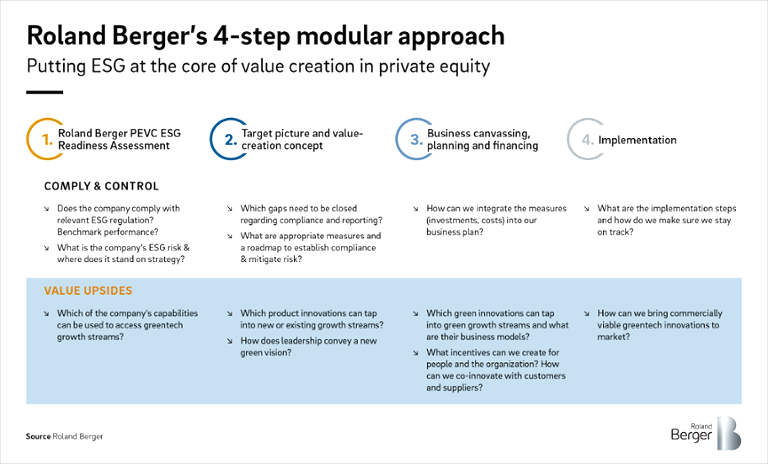Roland Berger supports clients in maximizing corporate performance and helps them to improve profitability and corporate value.


From gray to green
How private equity can create value in the European green transformation
There is no way around the green transformation of the economy. The leap forward is and remains a huge undertaking – also in financial terms. We believe that private equity, which currently manages around EUR 800 billion in assets in Europe, can act as a catalyst for the green transformation and play an important role in transforming gray companies into green ones. Our latest study identifies real and perceived hurdles and suggests strategies for transforming those challenges into opportunities.

The urgency of the green transformation
Global warming is real – and a major threat to society as we know it. Since 1990, global greenhouse gas emissions have increased by around 45 percent. If humanity continues along its current trajectory, the United Nations Intergovernmental Panel on Climate Change (IPCC) predicts devasting consequences, including substantial losses to biodiversity, extended heatwaves, loss of soil fertility and crop yields, and damage to the fresh water supply. Acting on climate change is the collective responsibility of leaders in politics, business, and finance.
To change the trajectory of climate change, developed and emerging economies tighten regulations. But the "economic green transformation" – most likely one of the most complex endeavors in human history – also requires substantial innovation and structural investment. The European Union estimates that the investment required in the EU in the period to 2030 will be around EUR 8 trillion, not accounting for inflation or growth.
Where will that money come from? Around one-quarter from the public sector. But private equity also has a major role to play as a catalyst for the green transformation – investing in ESG-compliant assets, actively transforming companies from gray to green and creating a change for good, at the same time as generating returns for limited partners. In this paper we look at the challenges private equity faces and suggest strategies for transforming those challenges into opportunities.
Investing in the green transformation is hindered by various challenges
In our research we learn that a large part of the PE sector looks at ESG more as another to-do rather than a chance to capture additional value. But, as we show in our Greentech Growth Compendium, there are significant growth opportunities ahead for companies – if there is a will to evolve and innovate. Nevertheless, this is a difficult task as various aspects of the green transformation are embedded within broader ESG frameworks, which also include social and governance requirements that sometimes even stand in conflict to one another.
We found that there are currently five challenges around the understanding of ESG, the way it is being implemented into the portfolios of the GPs and how ESG influences the interactions between Limited Partners (LPs) and General Partners (GPs), the interactions between GPs and their portfolio companies, as well as the operations of the portfolio companies themselves.
Leveraging the opportunities of the green transformation
We at Roland Berger are convinced that by actively addressing those challenges with value-creation concepts, companies can turn them into opportunities – with the help of our ESG-specific four-step modular approach that addresses each of the uncovered challenges and places ESG at the core of value creation, which is explained in detail in the downloadable PDF.
Register now to download the full study regarding “ESG in Private Equity” including key insights, suggestions, and current development for players in the private equity industry. Additionally, you get regular insights into future expectations for the industry with the focus on sustainability topics.










